David Lynch really loves vomit. Is it just a coincidence that creamed corn is also classic movie vomit? “The cheapest special effect ever,” says John Waters: “A can of creamed corn, and presto!” As Eugenie Brinkema (2011) famously put it, in Lynch’s world, “the figures do not vomit; the vomit figures.” And whaddya know? Summer of ’17, beginning of Twin Peaks: The Return, we find out that the entire narrative rests on what Denis Lim famously summarized, “murky doppelgänger metaphysics involving the very Lynchian combo of electricity and vomit.”
We can’t deny that vomit plays a role in Season 3. Like most of us, I assume the ‘structure’ and significance of Twin Peaks isn’t revealed in the linear narrative so much as in the hypertext where all the themes and characters are stacked in the space of the imagination and left to whisper and resonate. Lynch actually somewhat explained the structure of Season 3 to Jeff Jenson shortly after Part 3 came out:
It’s just like a magical thing. I also always say the whole thing exists in another room as a complete puzzle, all the parts are together, and someone from that other room is sort of a rascal and randomly flips parts over into this room. And then you have to put the puzzle together, but one is from the end of the story, one is from the middle, and a couple from the beginning, and you won’t know until it’s more formed what it could be.
Let’s click and expand on the four vomit scenes—one from the end, one from the middle, and a couple from the beginning—and treat them as pieces to the puzzle and as puzzles in and of themselves.
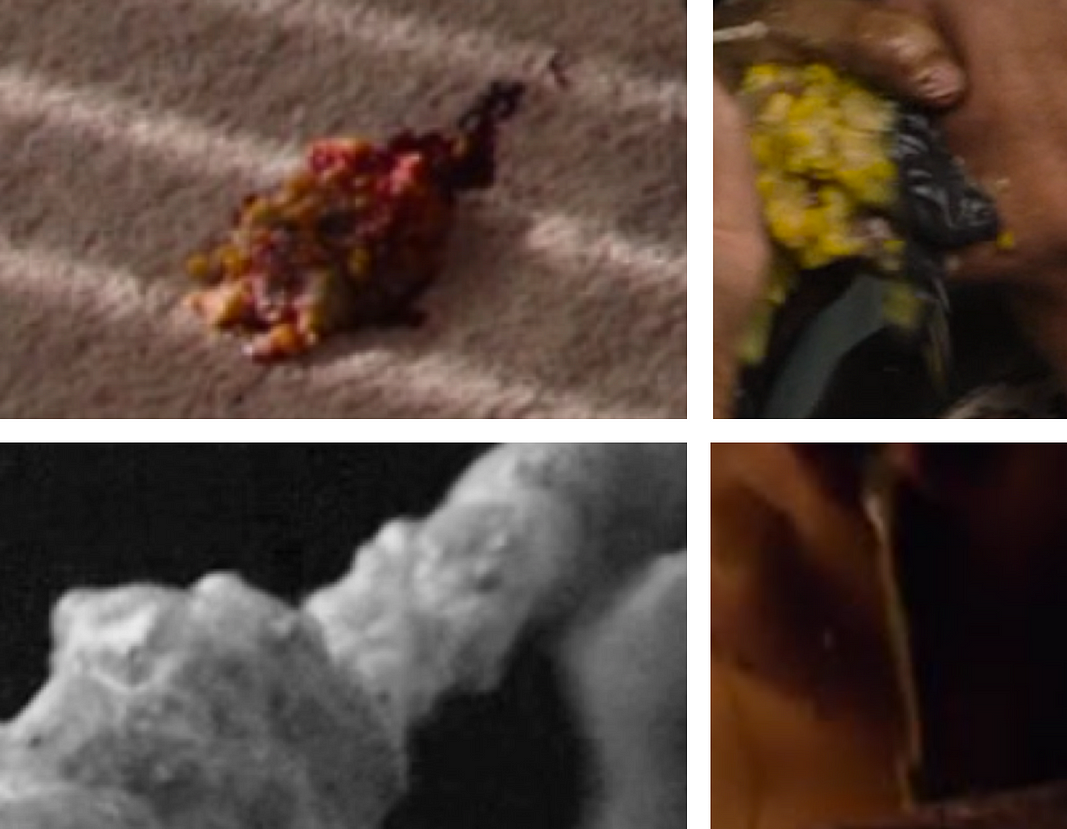
In Part 3, Dougie vomits cherry pie and Cooper vomits creamed corn and scorched engine oil. Our favorite Twin Peaks symbols back together again! As vomit! In Part 8, we witness a cosmic entity spew forth more key components of the narrative, and in Part 11, “Sick Girl” resurrects from the shadows and coughs up green slime for Bobby Briggs.
First, let’s keep in mind that artists employ vomit to ‘activate’ the audience because the disgusting is magnetic. Brinkema: “Vomit tempts; it solicits.” Kristeva: “The abject is edged with the sublime.” O’Toole: “With society a circus of sensations, anything truly terrifying (by definition, truly surprising) is saliva for a jaded palate.” (See Savoring Disgust by Carolyn Korsmeyer).
Lynch’s vomit is aesthetic disgust but also points to the gut-wrenching reality of psychological growth, “which is like speeding up in a car,” explains William Irwin Thompson, “only to slam on the breaks so that everything behind you in the backseat is precipitated into the front: the unconscious is hurled into consciousness where it can be dealt with—not as a hidden infantile program that unconsciously controls adult behavior, but as an open compulsion that can be illuminated and eliminated.”
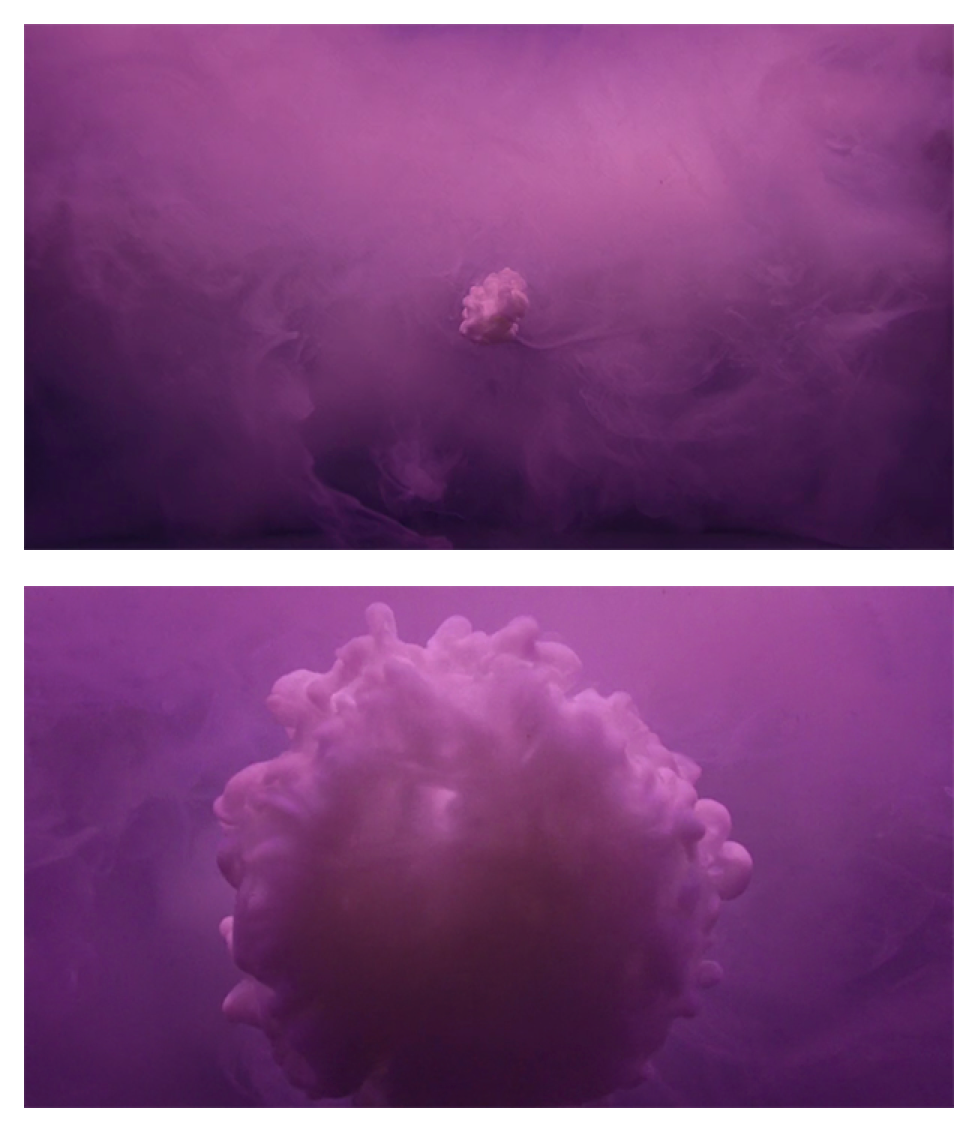
Hurled Into Consciousness
Each vomit is a different texture, color, and comes from a different character. In order of appearance:
- Dougie Jones, red and black, fairly solid
- Mr. C, yellow and black, creamed corn and oil
- Experiment/Mother, light gray (black and white), frozen slushy
- Sick Girl, green, bile/ink/slime
From the goo to the woo, these correlate nicely with larger Twin Peaks themes, famous vomit scenes from art and film history, and with the physical, psychological, allegorical, and mystical dimensions of our bodies.
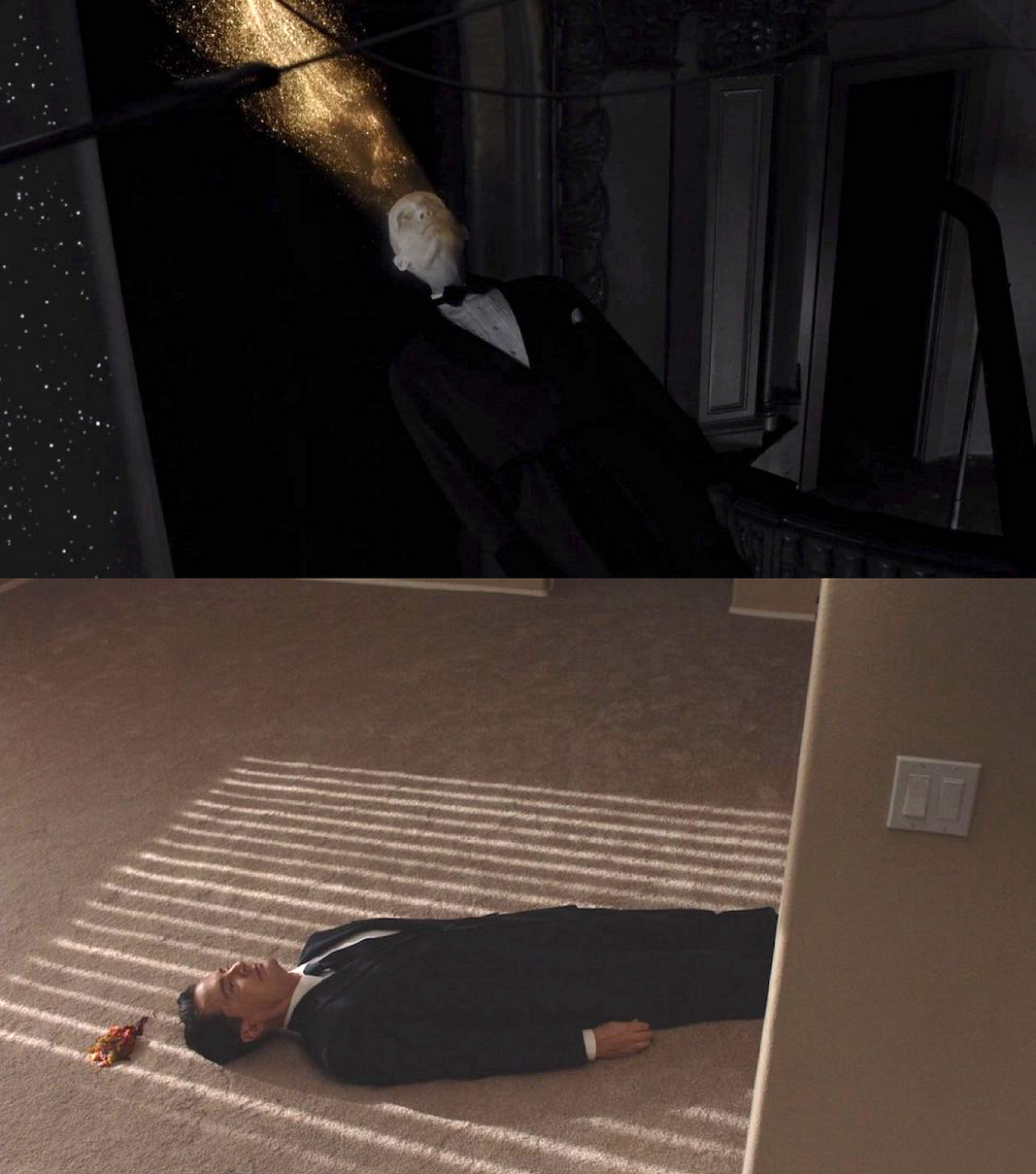
I feel funny. What’s happening to me?
Dougie vomits right before he teleports, like travel sickness in reverse—pre-shocks of future trauma. I bet he ate cherry pie with Jade, probably from Szymon’s Famous Coffees! Later in Part 11 the staff there will know exactly what he wants. Waiter: “A whole pie?” Dougie: “Whole pie.” Waiter: “We usually don’t sell the entire pie. What should I put it in? All I have here is this oversized cardboard box.” Dougie: “Carboard box.”
The vomit looks like cherry pie but also like a tiny monster. Diane podcast remarks on how the excreta, all nice and tidy in the middle of an empty room, looks like art in a gallery. Lynch probably built that prop himself or at least gave it some direction. In a behind-the-scenes shot, we see a wedge of foam—or is it cheese?—as its substructure. Further, it’s positioned right above Cooper’s head like a target—or like a crown: the sahasrāra, the Eye of Spirit, the purple “bridge to the cosmos.”
Vomit Art from the Darkness Within
There is a long tradition of vomit in film, particularly in comedies and horror, and an even longer tradition of vomit in art. Hieronymus Bosch compares a mouth to an anus and vomit to poop-money in The Garden of Earthly Delights (1515). What’s more, the poop-money, vomit, and naked bodies birthed from a world of blue all fall into the mouths of people living in a black puddle beneath the floor. A naked girl with a frog bug on her chest is fondled and protected by a couple of monsters who are also trees.
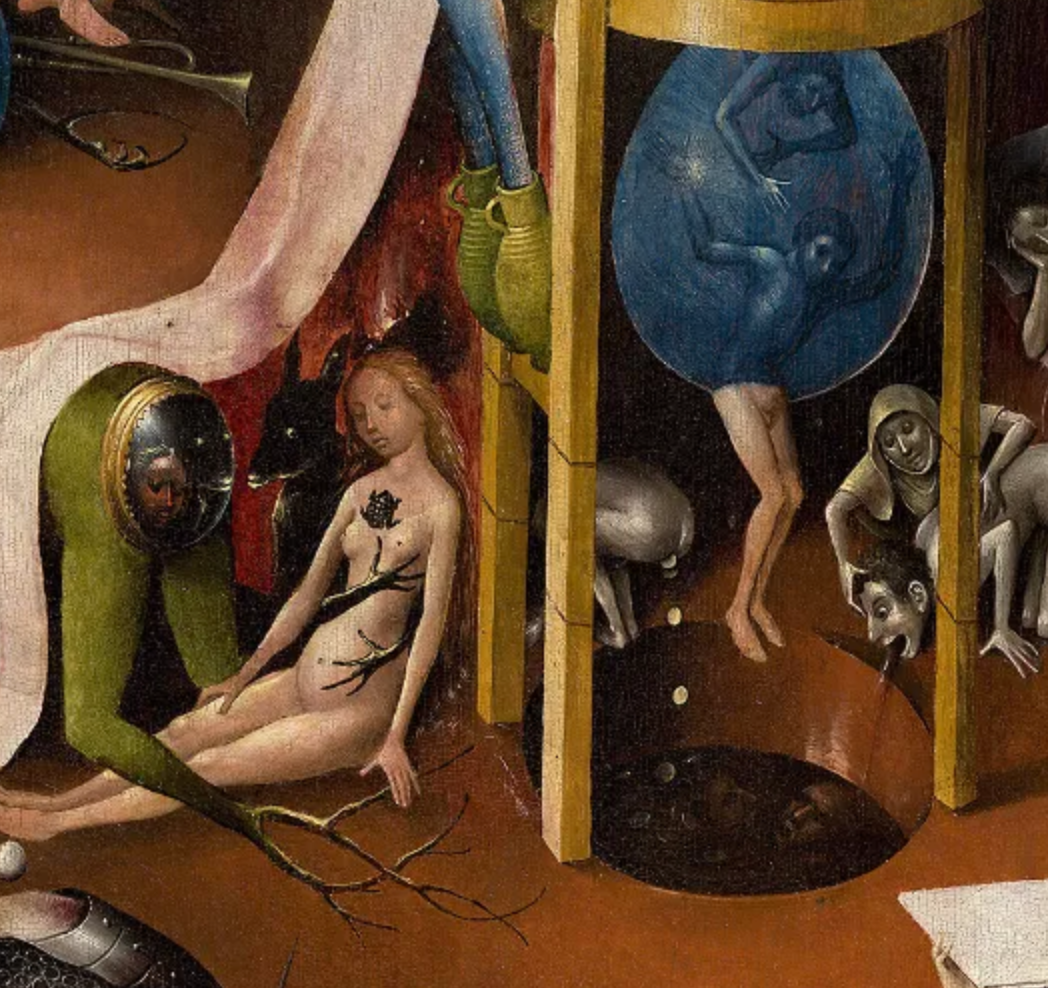
Hans Holbein draws a man vomiting in his 1525 book The Dance of Death. Paul Nudd in Vomitromiton (2009) uses fake puke with paint on canvas to depict a collection of microbes. Similarly, Sue Williams used fake puke in the 1990s, and now works with webs of viscera and spewing orifices in her abstract paintings like Two Parties, Lifestyles of the Rich and Famous, and Record Profits.
Hermann Nitsch’s drip paintings evoke blood, vomit, and shit (see other Viennese Actionists who used real vomit in their performances). In the early ’90s, the “patron saint of the party” Leigh Bowery of Minty used fake vomit to shock audiences.
The fairy godmother of slime Marilyn Minter glorifies weird substances coming out of women’s mouths in her large photorealist paintings and videos. Bjork’s video “Hidden Place” follows magical substances in and out of the artist’s mouth. Another music video was filmed from inside Bjork’s mouth. Bjork has a thing for orifices and the body’s numinous effluvia. See her spine spew gossamer ectoplasm in “Unravel” (2001), and her chest hurl kaleidoscopic toruses of dancing supercelestial beings in “The Gate” (2017).
Cindy Sherman photographs fake vomit (beef stew) in Untitled #190 and #175, or did she just say it was fake? Marc Brandenburg, in his 2011 series Where You Are Not, draws in graphite puddles of vomit he photographed in the streets of Paris. He says:
I know that many people are fascinated by the medium of drawing and I use that to attract people, to divert their attention to things or situations they wouldn’t otherwise spend very much time looking at… And these pools really seemed worth drawing. They have these wonderful abstract forms, and that’s how the viewers see them at first until they realize what they are. It’s then that the reflex of looking away sets in.
Takashi Murakami envisions psychedelic clouds of shape-shifting vomit in his gigantic 2002 painting Tan Bo Puking – a.k.a. Gero Tan. It depicts the character known as Mr. DOB, Mickey Mouse’s mutant cousin and Murakami’s alter-ego, playing the “monster” Tan Tan Bo in his death throes. Mini versions of DOB erupt from sores on his head, each one also vomiting vomiters. One stream ends in a high-five between two hands and a black star! Stepping back, the entire composition resembles a nuclear explosion.
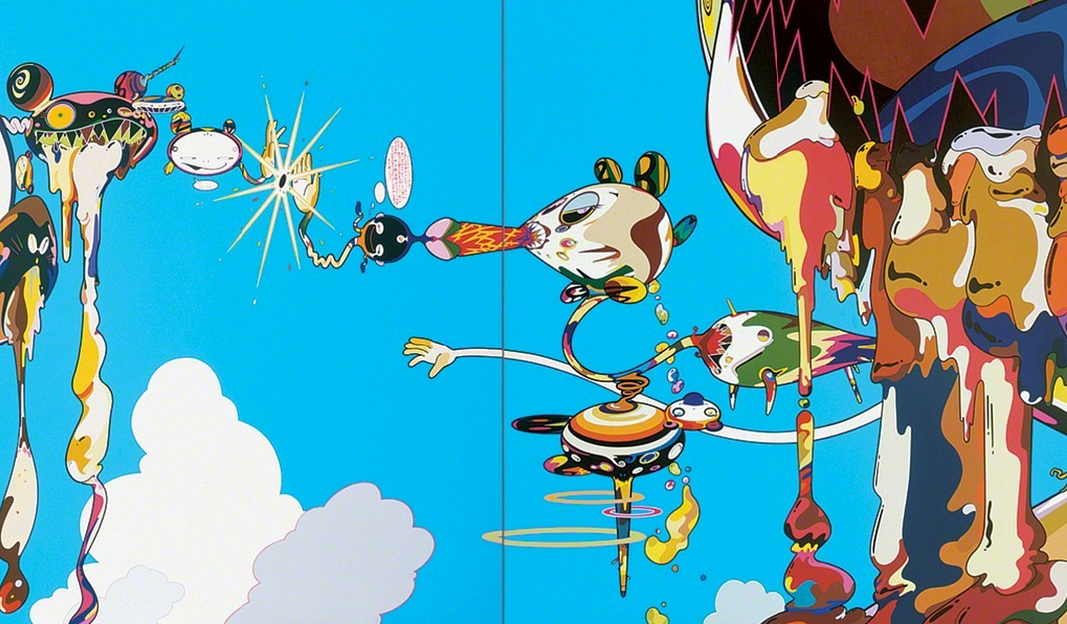
DOB is like BOB.
The imagination is a space of largely unconscious memory that can feel strange, mystical, even celestial agencies in the margins of consciousness and transform that information into dreams and artworks.
There are artists who paint vomit and those who use actual vomit imaginatively and symbolically. Jubal Brown in 1996 went to the MoMA in New York and deliberately vomited icing and blueberry yogurt onto a Mondrian painting in protest. He was really vomiting on Modernism. In 2010, also at MoMA, someone vomited behind Marina Abromavic during her performance The Artist is Present. In 2005 Kristofer Paetau puked in a gallery in Germany and it became a meme.
Paul McCarthy’s performances in the 1970s, like Hot Dog and Tubbing, involved force-feeding and vomiting. In the short film, Painter (1995), McCarthy interacts with a large tube of paint that appears to puke out its insides. There are moments in the film where McCarthy is fisting the tube of paint, the mouth suddenly becoming the anus. There are also moments when you could swear the paint was vomiting the artist.
In Nexus Vomitus (2011), Millie Brown spews colored milk onto the floor to make paintings, calling to mind Jack the Dripper. The great Mike Parr in 1977 performed The Emetics (Primary Vomit): I am Sick of Art (Red, Yellow and Blue), which involved a chair, curtain, and the artist puking primary colors onto paper on the floor. We see echoes in BOB spewing red garmonbozia through his arm onto the chevron floor. Parr, having been born with only one arm, says he takes his own deformed identity as a starting point and unfolds a…
confrontational and mystical artistic language of the radical that revolves around the psycho-social dimensions of the self and the community, subjectivity and memory, the issue of human existence and its control.
Vomit-as-Paint
Micol Hebron also works with vomit as paint in her 1999 multi-channel video installation, Fountains. For each film, she sits in the center of the frame wearing a different monochromatic outfit, holding a clear plastic bucket. Then she vomits into the bucket the same color liquid as her outfit. “The rainbow of images circles around the room and the viewer.” Like Lynch, Hebron says she wants to address issues of painting first and foremost, “issues such as color mixing, the color wheel, different color combinations, as well as the position of the artist as Creator and physical and psychological conduit for the production of art.” She wants her insides to match her outsides, what Bjork sometimes says when asked why she looks so weird.
Let’s also consider Sick Film by Martin Creed (2006). It’s a series of short performances by 10 different people (edited from 19) who walk into an empty room and proceed to shove their fingers down their throats and vomit. The camera does not cut away and we can hear all the gagging and burping.
Creed says there is a narrative: the vomits get bigger and bigger, the colors change, and the amount of time it takes for each person to vomit changes. The film isn’t available online, but art historian James P. Hanson explains: “Each person enters, vomits, and exits before an edit clears the screen of the vomit before another person enters to do their private business.” The entire film is about 20 minutes. For more details, check Hanson’s great essay “Sick Shit Happens.”
The first performance is available on YouTube.

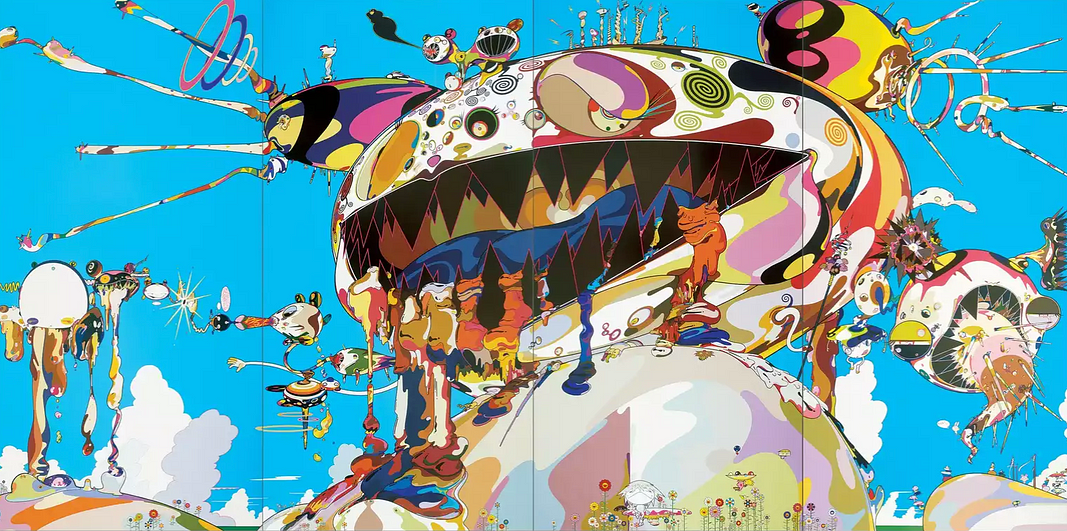

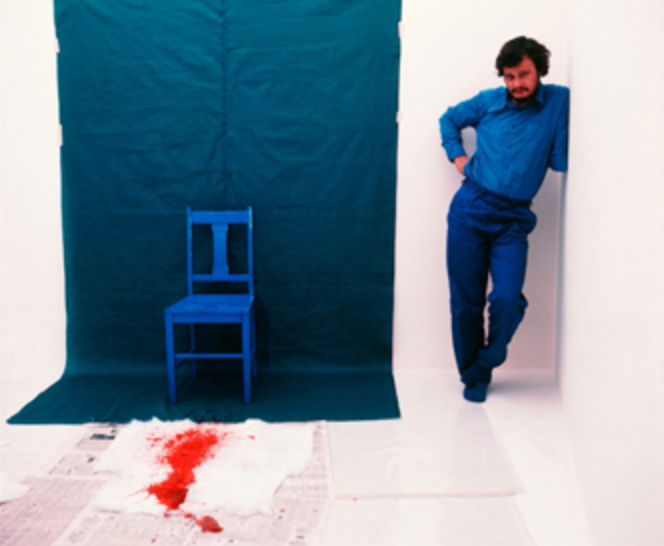
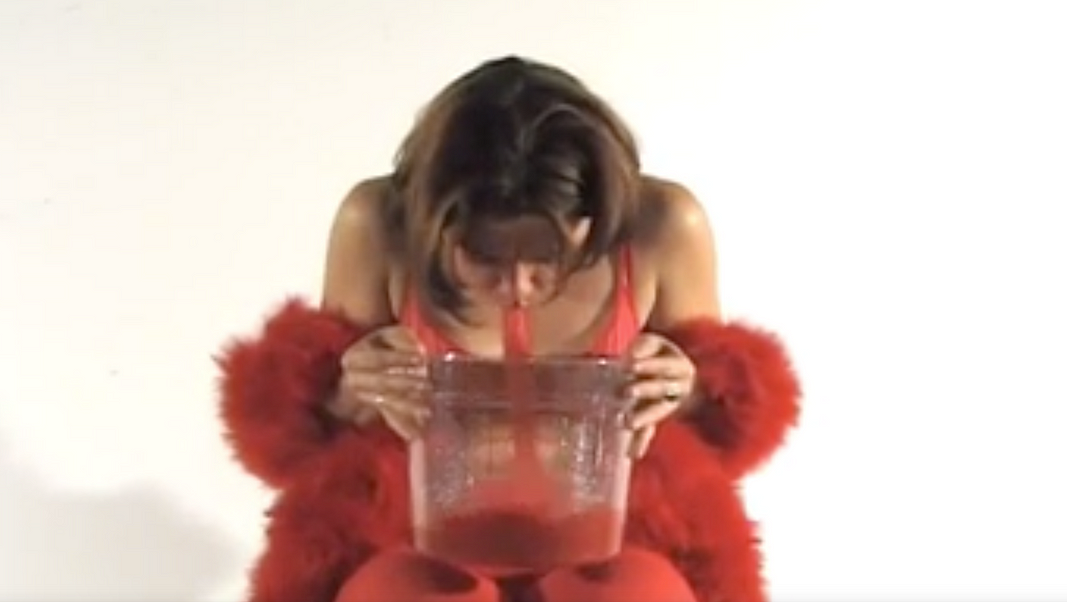

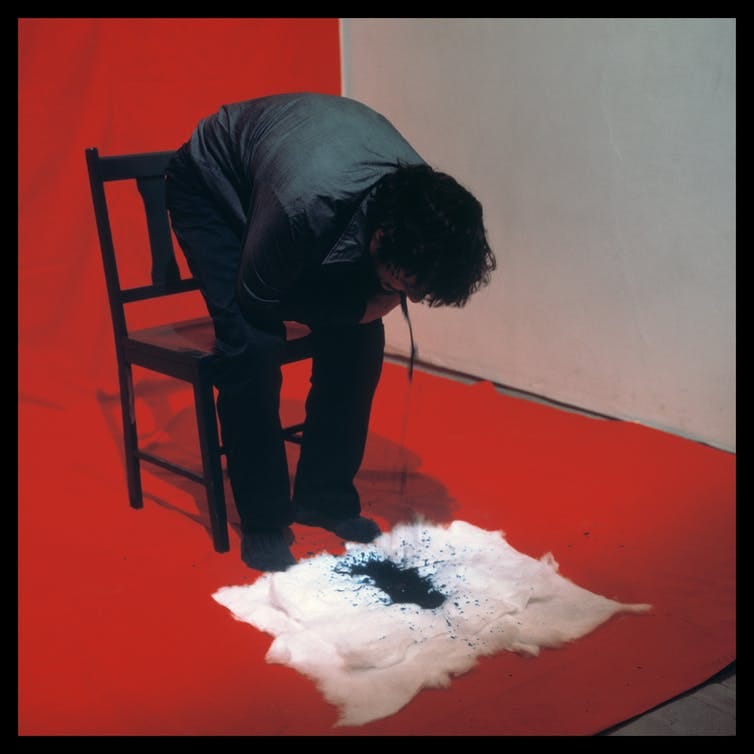
Sick Sh*t Happens
Creed’s vomit, like Hebran’s, Parr’s, Bjork’s, Bosch’s, and Lynch’s, is a metaphor for the art life and creative process—of “trying to get something from the inside out,” and coming to terms with what you create. Creed:
You don’t really know what’s going to come out, it’s painful, but you feel better afterwards. The films are like portraits of people expressing themselves […] something uncontrolled. I am sick and tired of thinking. I want my work to be more like a vomit than a rumination. I just want to go ‘Blah!’ or ‘Woosh!’
Brinkema, in Laura Dern’s Vomit (2011): “Vomiting is a brilliant image of the unstoppable narrative compulsion, proceeding relentlessly from the beginning, through the middle, to an end. At the same time, it is a completely involuntary process.”
A pool of afterbirth
Professor Lindsay Hallam in Drink Full And Descend points out that vomiting occurs at key points in Season 3 evoking birth, such as when Mr. C vomits at the moment Cooper passes through the light socket into Rancho Rosa. “He has been reborn.” Hallam calls Dougie’s vomit “a pool of afterbirth,” and remarks how “both vomit and afterbirth are bodily materials that are transgressive in nature, crossing the boundary between the inside and the outside of the body.”
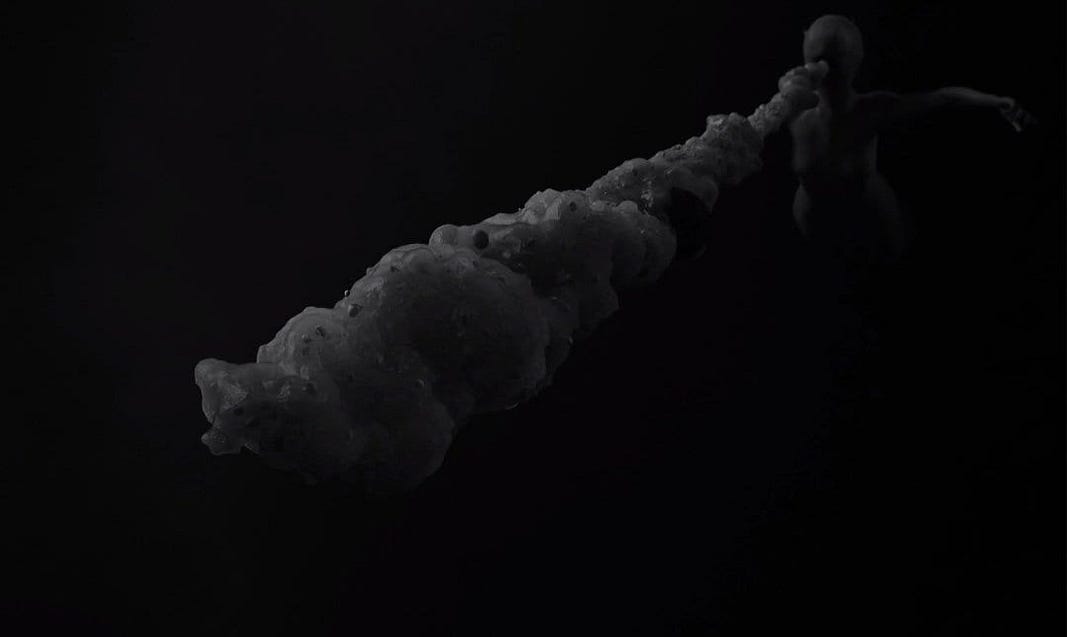
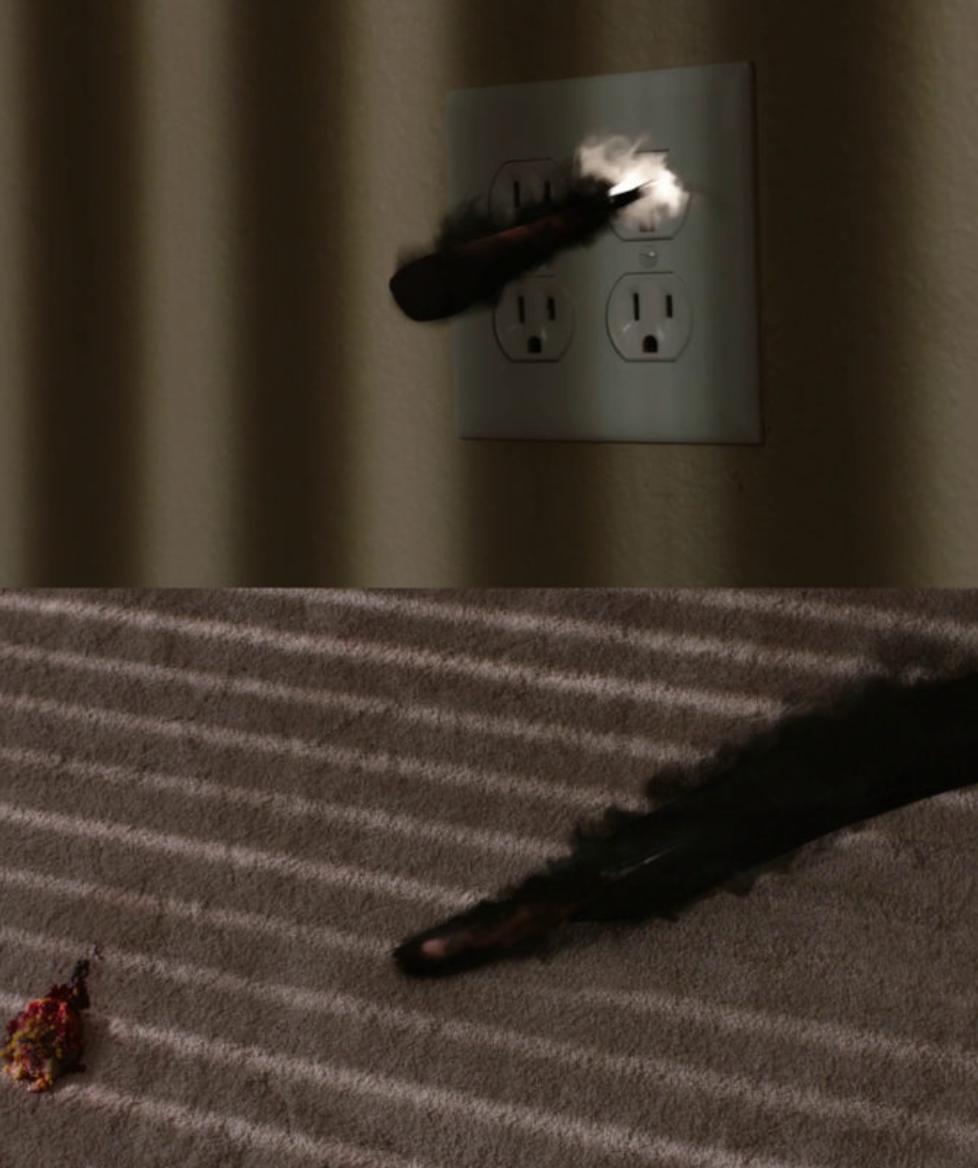
As if the wound too were vomiting.
Lastly, Dougie’s violent bending forward, along with the tidiness of his vomit on the floor—it looks more like an organ—resonates with a piece of spooky literature from Japan: the seppuku vomit scene in Yukio Mishima’s Patriotism (foreshadowing Mishima’s own seppuku):
But, suddenly stricken by a fit of vomiting, the lieutenant cried out hoarsely. The vomiting made the fierce pain even fiercer still, and the stomach, which had thus far remained firm and compact, now abruptly heaved, opening wide its wound, and the entrails burst through, as if the wound too were vomiting. Seemingly ignorant of their master’s suffering, the entrails gave an impression of robust health and almost disagreeable vitality as they slipped smoothly out and spilled over the crotch. The lieutenant’s head dropped, his shoulders heaved, his eyes opened to narrow slits, and a thin trickle of saliva dribbled from his mouth. The gold markings on his epaulettes caught the light and glinted… A raw smell filled the room.
Mr. C’s Vomit
Spewing to a cartoonish extreme, the sight and sounds of Mr. C’s vomit definitely tug on the sympathetic nervous system, but we don’t puke. William Paul in Laughing Screaming talks about how movie theater staff in 1973 had to clean up loads of vomit after screenings of The Exorcist. Can you imagine the smell!? Now we’re used to seeing puke on the big screen. It’s a TV trope. Now we groan, laugh, or look away for a second to keep our stomachs from rising in sympathy. Seeing it is easy, but if we smell it, all bets are off.
Twin Peaks highlights not only the sight but also the smell of puke: its invisible power. Brinkema (2011):
In place of recuperating disgust for the visual by treating puke as something seen and not smelled, Lynch lets his vomit linger and reek; it orders bodies around, frames and hunts, reveals and accuses — it damns.
Just the smell of Mr. C’s vomit damns two policemen to the hospital! It’s interesting that William Miller in The Anatomy of Disgust (1997) calls vomit more disgusting than feces due to its uncommonness (we have an almost daily engagement with feces), and also because of its weirdness: it’s Douglasian “matter out of place.” Things are never supposed to come out of the mouth. When they do, something’s wrong.
With vomit, the sacred mouth becomes a source of disgust like the anus. Suddenly, heaven expectorates evil. More, bad smells can make people act more evil, can cause people to shun certain minority groups, at least temporarily. There’s evidence that the more “disgustable” you are, the more likely you are to be politically conservative since one of the core mechanisms of disgust is this idea of shielding the ‘body’ from the outside. Rachel Herz, author of That’s Disgusting: Unraveling the Mysteries of Repulsion:
If you look at someone’s face who’s disgusted, you see them squinting their eyes. They’re actually taking in less light to avoid seeing the disgusting object….It’s all about protecting the holes on our face, as it were, from contamination.
Disgust: the “forgotten emotion.” James Aho in The Orifice as Sacrificial Site expands on the significance of the mouth and its excreta by offering the image of the body as one’s holy land. He argues we develop “orifice regimens” and police our personal geographies only to then project these attitudes onto our social and cultural geographies. We must protect our borders from “contagions” like immigrants, and protect our minds and eyes from viruses like pornography and “sick” ideas.
In any case, this torrent of daytime vomit may be the most disgusting puke sequence ever filmed! It’s definitely up there with Stand By Me, Monty Python, Team America, The Exorcist, The Fly, and Jessica’s Body. We’re forced to look at it for so long that we move past the first reaction and into an aesthetic one. Like watching a waterfall or a volcano erupt, on some level, it feels good to witness someone get—everything—out. (It feels good to hear Cooper finally urinate.) William Paul wonders if the viewers of The Exorcist were really vomiting in an act of identification with the exorcism.
Mother’s Atomic Regurgitation
When Carl Jung was 12, just the thought of God pooping induced fear, resistance (“Don’t think of it. Just don’t think of it!”), shame, and then a mystical experience he’d later describe as pure grace and “unutterable bliss.” Lynch and Frost ask us to imagine God vomiting. Vomit is dirty, sure, but theologically it’s also a root symbol for divine Creation. ‘Emergence stories’ are often expulsion stories, banishment stories. People are always getting thrown out of gardens, angels are expelled from Heaven, ancestors are hurled from the sky or from the ocean or from the mouth of some deity. Even the Big Bang is an expulsion myth.
Birth is an expulsion. Kristeva in Powers of Horror and Barbara Creed in The Monstrous-Feminine argue that abjection is almost always linked to representations of the mother. We are all abject matter, from the womb to the tomb. In this pivotal scene from The Return, vomit is compared to not only a cosmic birthing/aborting of a raping spirit monster by someone called Mother, but also to a nuclear explosion. The scene works as art, what Kristeva calls “that catharsis par excellence,” and as religious myth—another catharsis par excellence. You know what else is a catharsis par excellence?
Vomit Tales
Perhaps the proper way to study vomit is religion. In the Democratic Republic of Congo, the Kuba people have a creator God named Bumba who vomits everything and everyone into being. In Japan, the great Izanami, mother of all gods, burns her vagina giving birth to Fire, and in her agony, she throws up and more gods are born from her divine vomit. In India, when Krishna’s mother looks inside his mouth, she sees the whole complete entire timeless universe.
In the Judeo-Christian imagination, Yahweh (or Elohim, or Ialdabaoth) vomits the universe or he ejaculates it; we’re not certain. The crowning image has to do with “splitting his waters.” Psalm 77:16: “The waters went into a panic attack: they writhed and convulsed.” Wrestling the water dragon Leviathan to bring about order from chaos is full of vomit imagery.
While female creators, in general, give birth to the universe, male creators tend to ejaculate, spit, cry, vomit, sneeze, dream, even sh*t out the universe. In Mesoamerica, First Father famously cuts open his stomach and lets the tree of life grow out of his guts, beautifully depicted in Aronofsky’s film, The Fountain. With what we now know about sh*t being alive (100 billion bacteria per gram), it’s not that crazy of an image.
Abrahamic texts bring up vomit a lot, as revelation and defilement. There are countless Christian sermons on vomit, Islamic interpretations of dream vomit, and Hebrew texts that link vomit to other “impure” and disgusting substances like feces, urine, menstrual blood, semen, and “dead matter“—bodily substances always related to concepts like class, ethnicity, sex, and animality. Akin to black goo, vomit is haunted, which is why we need to keep our eyes on it.
Four major vomit themes stand out in The Bible. In no particular order: The Whale vomits Jonah; Earth vomits her inhabitants; Jesus vomits the lukewarm, and a dog goes back to his vomit. Also, in Isaiah 19:14, Egypt is compared to a man staggering through his own vomit. In Matthew 12:40, whale vomit functions as a metaphor for Jesus’s resurrection.
Vomit is a disgusting and divine substance in the Japanese imagination, too. Oddly, it creates food, not the other way around. A goddess named Ukemochi vomits food into the world—fruits, vegetables, fish. Her vomit also inadvertently causes day and night to come into being. According to the Nihongi, the Moon was sent to earth by his sister the Sun, Amaterasu, to visit the puking goddess. When he arrived, she welcomed him by throwing up a torrent of food onto the table! Moon was so grossed out and horrified that he drew his sword and killed her, right there in her home. More food was created out of her sacrificed body — beans from her mouth, millet from her eyes, and rice from her guts. (In Japan, rice is the soul, and the abdomen is where the soul resides, hence why seppuku “hara-kiri” releases the soul). When Moon told his sister this, she was devastated and said definitively, “I never want to see your face again.”
In the West, Kronos a.k.a. Time ate all his children (so he thought). Zeus became his cup-bearer and put a special potion in Kronos’s wine that caused him to vomit up Hestia, Hades, Demeter, Poseidon, Hera, and the “omphalos stone” he thought was Zeus. We see a positive association with vomiting. Tangentially, a Buddhist monastery in Thailand specializes in vomit-yoga for drug addicts (originally designed for opium smokers). The monastery uses a top-secret brew of 108 ingredients as an emetic. Each day, after the person vomits, the monks and nuns celebrate with bells, drums, and singing. They celebrate the excreta like our parents did before they shunned it.
Some ceremonial art objects are meant to evoke our insides. Beautiful Taino purging sticks or “vomit spatulas” and “emetic drug delivery vessels” help people vomit. The Taino (first tribes to encounter Christopher Columbus) practice ritual vomiting and inhaling DMT cohoba (yupo) from a cavity carved into the head of a spiritual figure.
One Taste
I can attest that in religious purging practices, vomiting forces instant surrender. We finally give up, let go, let God, and the self has no chance to struggle or make up stories. Usually, this ‘ritual vomiting’ is experienced as cleansing or cathartic, “as if one is purifying oneself of emotional garbage, such as fear, grief, guilt, or anger,” says William Richard in Sacred Knowlege, Psychedelics and Religious Experiences. It takes us to a place where boundaries begin to break down, where, as Kristeva put it, “we are confronted with an archaic space before such linguistic binaries as self/other or subject/object.” It can also, according to the Dalai Lama, give us a glimpse of the “clear light mind” of death. When we vomit, faint, fall asleep, orgasm, sneeze, or get hit in the face with an inflatable ball, the ego and its time get pushed aside for a moment, and we are dunked into the timeless, the groundless, the selfless. It might seem meaningless, even disappointing, but that’s also the point: vomit momentarily erases—with a bolt of endorphins—all dreams of self and significance.
The Dalai Lama also explains that the clear light mind, a.k.a. your “original face,” is like the surface of a mirror—ever-present but obscured by reflections. We look right past it! Nevertheless, it’s the part of you that’s ultimately “real,” unconstructed, absolutely present during all changing states. Ramana Maharshi: “That which is not present in deep dreamless sleep is not real.”
The only thing that is present during waking, dreaming, and deep dreamless sleep is “pure consciousness.”
Ectoplasm Art and Golden Linghams
That the vomit appears frozen in space, black and white, and contains a tiny face is no doubt a reference to Victorian photographs of ectoplasm. Spirit photography plays a big role in the history of film and horror. Nancy West writes that by the turn of the 20th-century it had developed into elaborate theater and even into miniature horror shows. The lights had to be off completely, and the ectoplasm had to be reabsorbed into the medium, so there was never any evidence except for the photographs. People would pay good money to get to see any evidence of ghosts, and they also trusted photography to capture the truth. Now of course we know that you don’t take a photograph, you make a photograph.
Ectoplasm is a complex symbol. Like biological ectoplasm (the cytoplasm extruded by an amoeba to help it move through space), spiritual ectoplasm leaks out of a medium’s eyes, nose, and mouth to help them connect with the spirit world. It is gossamer, webby, even rubbery, and sometimes faces appear within it to help performers convince the public they’re really getting in touch with the dead. In a sense, Twin Peaks: The Return is a kind of ectoplasm: a way to see Frank Silva again, and, more broadly, an externalization in order to help us move forward.
Contemporary artists like Tif Robinette, Michael Barraco, and Marc Ryden like to work with ectoplasm imagery, and photographers Maria Molteni and Lacey Prpić Hedtke invite us all to participate in their DIY Ectoplasm Selfie project in the spirit of Eva Carrière. See also The Ectoplasm of Self Delusion, a kinetic sculpture by Ian Wolter, and Mike Kelly’s series of Ectoplasm Photographs from 1978-2008.



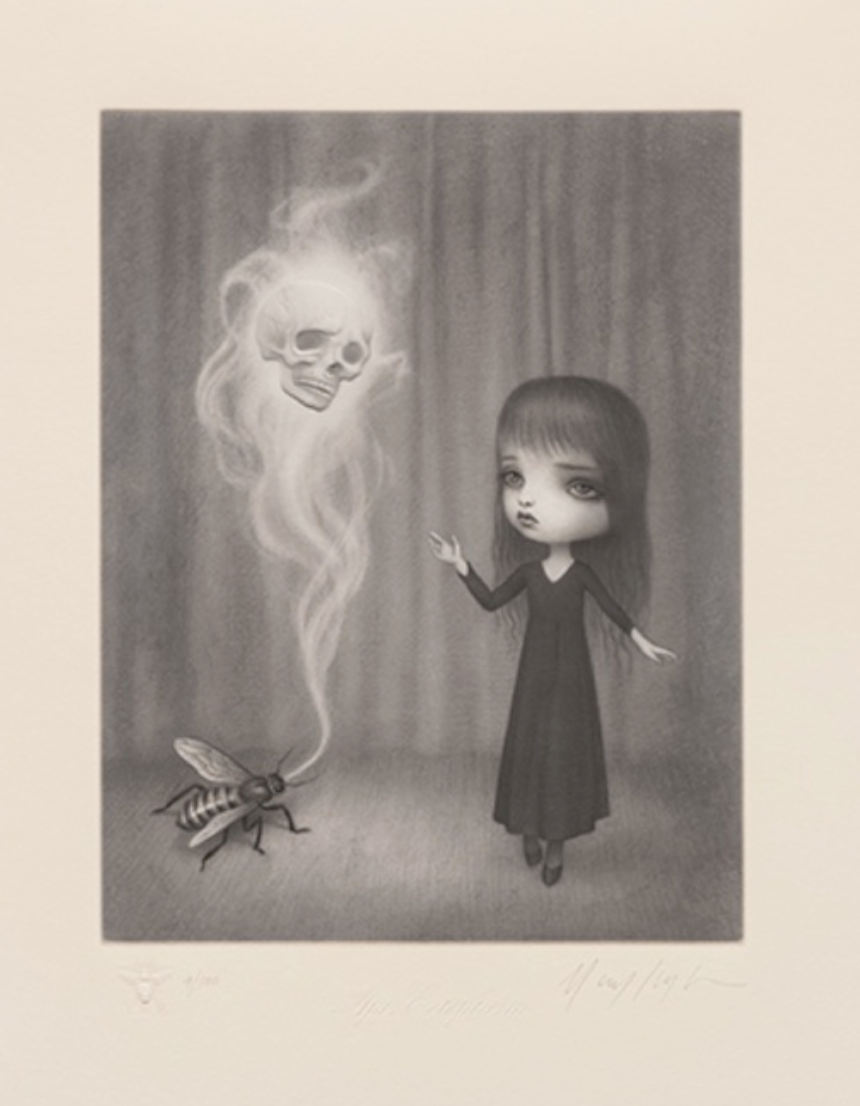

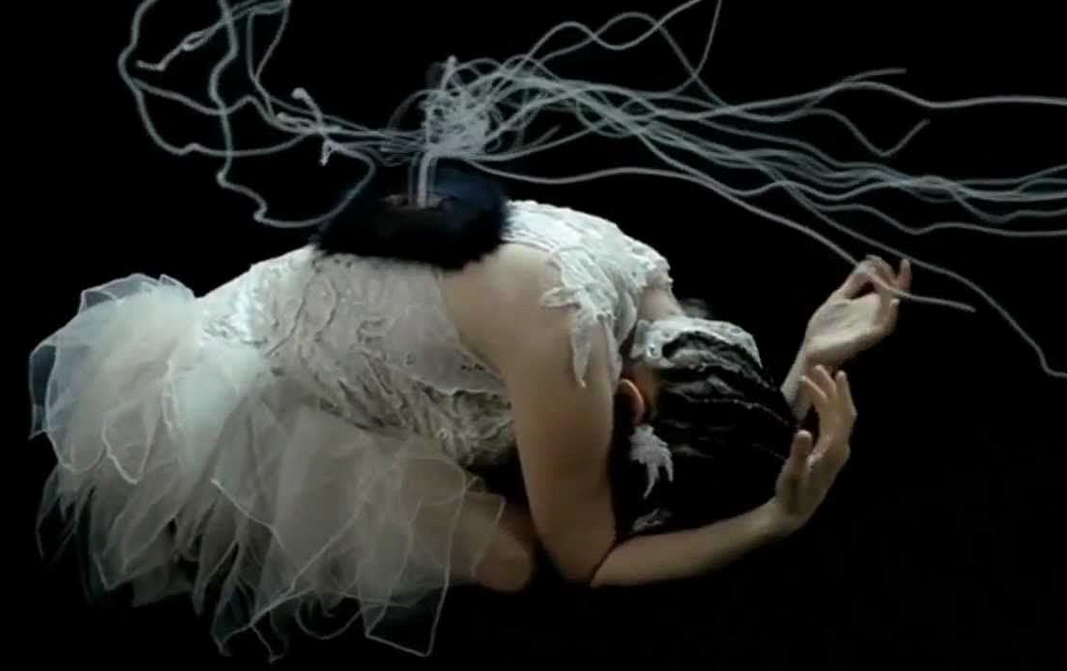
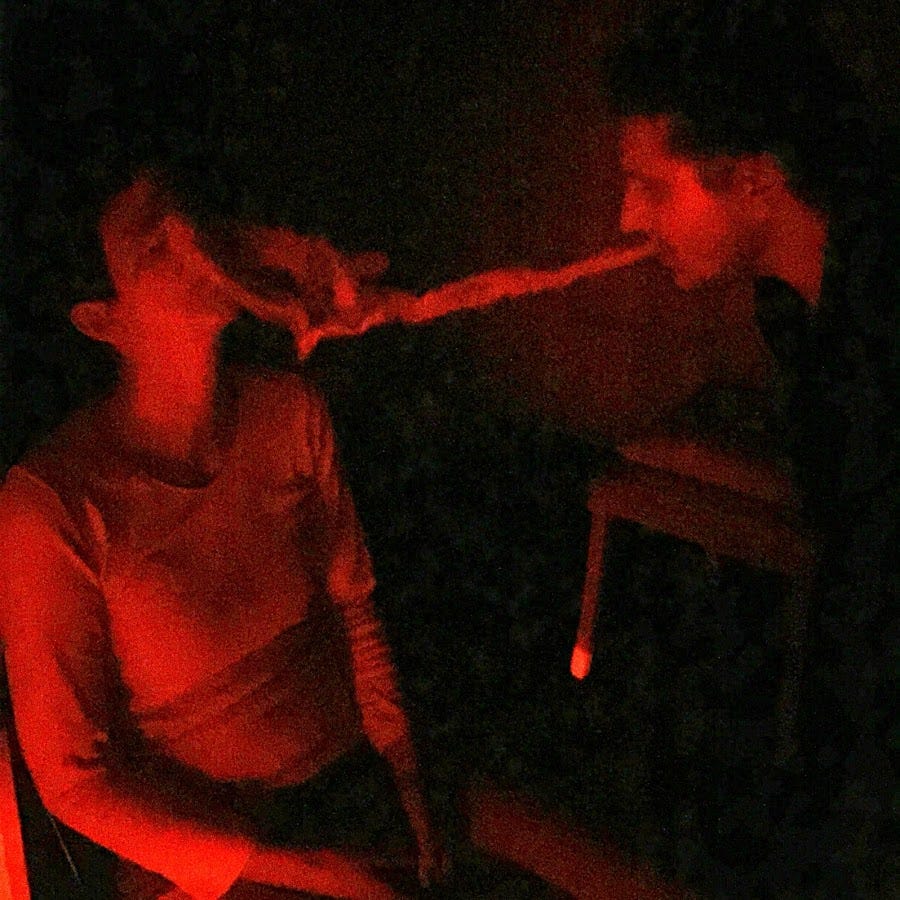

Contemporary German medium Kai Muegee claims he can produce ectoplasm and other manifestations or apports. Similarly, the Indian “avatar” Sathya Sai Baba was famous for his manifestations and would sometimes “give birth” to golden eggs called “Hiranyagarbha Lingham.” There are videos of both Sai Baba and Viswananda vomiting these other-worldly eggs. Note that this kind of spiritual magic (and prestidigitation) is part of Transcendental Meditation’s heritage.


The Torus
The body is a material casing that is alien in many ways, especially in its capacity to produce disgusting substances. We are mobile digestive tracts, says Earnest Becker, “worms and food for worms,” and more open than we care to admit. Dr. Michael Gershon:
The space enclosed within the wall of the bowel, its lumen, is part of the outside world. The open tube that begins at the mouth ends at the anus. Paradoxical as it may seem, the gut is a tunnel that permits the exterior to run right through us. Whatever is in the lumen of the gut is thus actually outside our bodies.
Eugenie Brinkema:
Vomit’s gagging richness relies on precisely this conceptual flexibility: the expulsion of the contents of the stomach through the mouth links gut and face, bowl and rim, deep bodily space with orifices that open to the outside, and it, therefore, hovers between structures of interiority as they are riddled through by unknowable, unspeakable, unfathomable exteriorities.
Re-mapping the soul
Vomit is an image for purging (spiritual, mental, and physical) and also for its evil doppelganger: abjection. David Macey describes abjection as “…both the founding and traumatic moment of separation from the child’s archaic and undifferentiated relationship with its mother, and the process of the expulsion from the body of substances such as excrement or menstrual blood.” Julia Kristeva says abjection is a process of physical and psychological purgation whereby ‘impure’ parts of the self are expelled in an attempt to preserve a ‘pure’ self.
The abject is also that funny feeling when, as Margaux Shraiman puts it, “the visceral interior realm becomes exterior and therefore visible, disrupting societal norms and conventional identity.” But the thing is, whatever is “abjected” is still an aspect of the person. Kristeva: “I expel myself, I spit myself out, I abject myself within the same motion through which ‘I’ claim to establish myself.”
You’re impossible!
Humans are abjection incorporated. Abjection (lit. “to throw away”) is necessary the same way vomiting is necessary—bodily and psychological integrity requires the exclusion of certain aspects. It just does. Becker: “When people do not have self-esteem they cannot act, they break down.” As we identify with only facets of ourselves, the rest is actually felt to be not-self, alien, scary, abject. In No Boundary, Ken Wilber describes this process as the individual “re-mapping the soul.” Lacan’s concept of the “mirror stage” likewise suggests that we tend to deny aspects of ourselves that do not correspond with our self-image. Abject matter includes traumas, memories, shadows, compulsions, and the more physical—gross—stuff like vomit, sh*t, and piss—any part of you that you need, or want, to wash away.
Sweat, boogers, wax, oils, semen, blood, snot, sick thoughts… Kristeva: “I feel like vomiting the mother.” But push down on a spring and it pushes back. “Eventually,” as Michael Garfield recently put it, “the cognitive dissonance of disregarding the anomaly becomes overwhelming.” The repressed or disassociated elements “erupt” to undermine our sense of self, and part of life is getting caught between an ideal image and the return of repressed elements.
This is interesting considering The (American) Experiment’s black and white spew resembles the stem of a mushroom cloud.
Sick Girl’s Vomit
Mary Douglas: “Where there is dirt, there is system.” Somehow, on top of the screaming woman, loud noises, and underlying confusion, the vomit in Part 11 ties everything together. I have a feeling that this scene inside the car, inside a box, is symbolic of the show and our own thoughts about it. Bobby, with us, watches the story unfold through a window.
Twin Peaks is not a linear code but is more like a myth that works through a system of correspondences. A little girl vomiting in a car at night is a mirror image of Mr. C vomiting in a car during the day. It’s also a compressed externalization of Bobby’s life in that moment (a f*cking nightmare), and it stands for, as the great Jeff Jenson put it, “demonic affliction or profound neglect of internal rot—or both.” There’s a reference to Ronette rising from her coma, a nod to The Exorcist (famous for its green vomit), and a flashback to Jane Margolis vomiting to death in Breaking Bad, the psycho-slime that appears in Howl’s Moving Castle, and the acid-slime from The Fly.
Is she really possessed or just joking? She looks like a girl acting like a zombie, spitting up green energy drink just to f*ck with her mother/grandmother/aunt. Or maybe she’s really sick. The whole town seems to be feeling something. Is she on sparkle? Weird, sparkle is a way to describe anime vomit—or better yet, disguise it. In the broader language of film, a girl vomiting is short-hand for “she’s pregnant.” The girl looks about 12 or 13 years old; she could be pregnant. Why haven’t they seen her uncle in a very long while!? This scene can read as the beginning of another horrific story of child abuse as well as a bizarre dream transfiguration of the car-honking scene from Fire Walk With Me.
Memento Mori
Is she choking to death? Why isn’t anyone doing anything? Vomit is an associate of death. For real, every year thousands of people in the US die from choking on it, mostly drug addicts and old people from aspiration pneumonia. In this sense, vomit haunts Laura and it haunts Dougie. Vomit is a reaper.
As someone with a common case of emetophobia, writer Jeannette Cooperman describes what it’s like seeing an increase of vomit scenes in mainstream media. “I feel assailed. Granted, others feel that way about sex or profanity, which leaves me quite cheerful. But surely regurgitation causes a little recoil even in normal people?” Perhaps, but some people actually find body horror and vomit scenes rather relaxing. Just imagining yourself vomiting can make you feel better. Sarah Kathryn Cleaver: “When I’m anxious, hurt, or humiliated I sometimes imagine vomiting supernaturally. Rivers of black slime or pink corn syrup are expelled from my mouth, and the unbearable, inexpressible feelings are on the outside, separate from me.” Maybe Bobby imagined all this to make himself feel better. He’s still sitting in the booth, gazing out the window.
One of the most powerful tantric yogas from Tibet is tonglen, “taking and sending,” which asks that you imagine sucking in disgusting, putrid, vomit-like substances (pure suffering) deep into your body, and then spewing out rainbows of sparkling, healing light and love, “exchanging self for other.” This opens the door to bodhicitta. It’s worth noting that there is also a “vomiting dog” pose in Tibetan yoga, accompanied by a “visualization of the hollow body.”
The Shoes
Death is not an error, it’s not a failure… it’s taking off a tight shoe. ~ Ram Dass
While Dougie and Mr. C puke, Cooper—the “real” Cooper—doesn’t vomit at all. Instead, he leaves behind his shoes; they fall to the floor like vomit. I’m reminded of Tibetan stories of enlightened people who achieve the “rainbow body phenomenon” at death. Their bodies “shrink” and sometimes even disappear, “self-liberate” into a non-material body of “light” (a Sambhogakāya) with the ability “to exist and abide wherever and whenever as pointed by one’s compassion.” And, for some reason, these enlightened people leave behind their hair and fingernails. If the body is cremated, then crystal “beads” and “pearls” called ringsel miraculously emerge from their bones and become relics. As the American GI tells Hedwig: To walk away, you’ve got to leave something behind.
In the visual and narrative logic of Twin Peaks, the shoes are vomit. How can this be? Both reveal something about the person, are markers of identity, confessions, and both are loaded with significance in Twin Peaks. Are Lynch/Frost hinting that we should read into vomit as we read into shoes? Catherine Spooner in Return to Twin Peaks (2015) argues that shoes in Seasons 1 and 2 are “overloaded with significance” and function (like vomit) as interjections or “disruptions.” Maybe vomits are the shoes of Season 3. Cooper will need new shoes, and Spooner reminds us that needing “of a new pair of shoes” is a traditional gambling expression, foreshadowing Mr. Jackpots. Also, while in a brain-dead state, Leo back in Season 2 mutters, “new shoes,” and this alerts Bobby and Shelly to the location of new clues.
Conclusion
In Season 3 we witness the show sort of regurgitate itself and we find new clues and new mysteries inside of stomachs. Hopefully, this essay has made clearer the reasons artists use vomit, and how vomit invites us to experience transformative spaces of revelatory possibility.
What do you think? What else are the four vomits telling us? Please share your ideas, arguments, and questions in the comments.

Extra Notes
More vomit: In Episode 32 of Diane, “Call For Help,” Rosie points out that vomit is probably what’s staining the dirty casino woman’s shirt, a woman who, being elderly and apparently homeless, is also abject matter. Did she vomit when everyone else did?
Vomit game: Dougie makes no attempt to hold in his vomit. Is this what determines who gets pulled back into the Black Lodge? What is this, kindergarten?
A puking game is at the heart of Disney’s Luca, and in Ghibli’s Spirited Away puking is the main theme. The name Haku literally means puke, and each purge prefigures joy and healing. One puke even leads to the creation of a tiny religion!
Does a puke game exist in any other myth or story, or is this entirely a Lynch/Frosts invention? In Spirited Away, holding in the food seemed to keep NoFace lost and insane. Puking, as well as getting out of that bathhouse, leads him back to himself.
Maybe vomit acts like a beacon or landing pad, so that if Mr. C. had vomited first, Cooper would have been sent to that location instead.
Buddha barf: Buddhism includes stories of realms where people known as pretas or “hungry ghosts” wonder the landscape, eating and vomiting. There are 36 different kinds, each linked to the “food” they consume. Some are called “Vomit-eaters.” In Twin Peaks, they’d be called Garmonbozia-eaters. The intensity of their suffering depends on this frustrating pursuit of sustenance. Some hungry ghosts eat sh*t. “We are horrifying, and our nature is to suffer.” One has to imagine that the gory depictions of hungry ghosts are poetic descriptions of human life.
Also within Buddhist literature, there is a Jataka tale where the Buddha is a street dog detective who uses vomit to reveal which dog chewed up the king’s leather. Vomit is a type of confession.
For Rosie, Adam, Mark, and Bobsy.




I came to same conclusion about photos Spiritualist mediums spewing ectoplasm influencing David Lynch. I think you could have delved deeper. But regardless that was a fairly exhaustive analysis of vomit and pop culture. Well done. Also gross and way too long